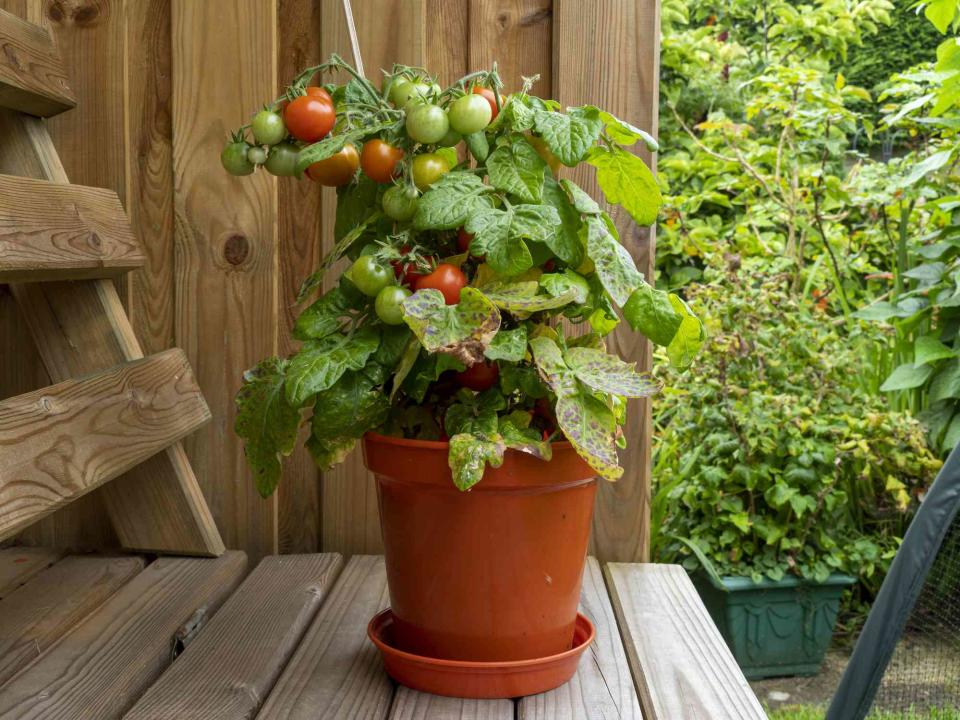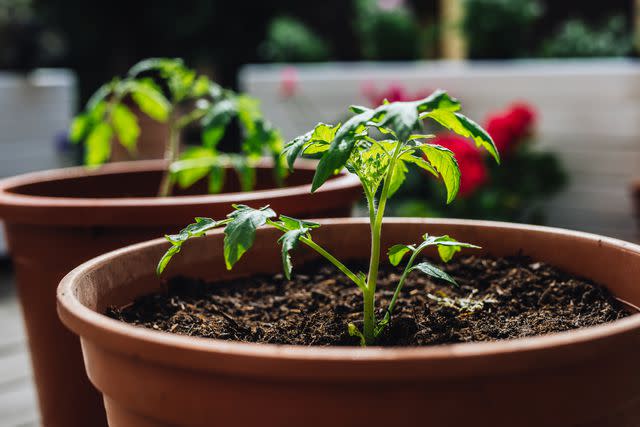Learn To Grow Delicious Tomatoes In Pots With This Comprehensive Guide
Grow juicy, ripe tomatoes no matter how small your space.

Angie Cottingham / 500px / Getty Images
Whether you’re trying to make the most of a balcony or patio, or you’re hoping to grow a small kitchen garden right outside your backdoor, growing tomatoes in pots is the gardening hack you need. Planting your tomatoes in containers saves space and offers flexibility as your garden’s needs change, but you’ll still get that same juicy, sun-ripened taste of summer that you’d have with an expansive in-ground garden.
However, despite the same end product, growing tomatoes in pots requires a slightly different approach and process. Here’s what you need to know to grow the ripest tomatoes you’ll taste this season.
Meet the Experts
Kitti Cooper is the Owner of Cooper Farm in Foley, Alabama.
Andy Thewlis is Farm Manager at The Inn at Little Washington in Washington, Virginia.
Tomato Varieties That Are Perfect for Growing in Pots
While most tomatoes can be grown in pots, that doesn’t mean all tomatoes are the best choice for growing in pots. You’ll want to look at determinate versus indeterminate varieties. Determinate tomatoes grow quickly but stop their vertical growth at a specific height, generally around four feet tall. They tend to grow in a more bush-like pattern, which can make them better suited for containers, but their fruit-producing season is limited to four to five weeks.
Indeterminate tomatoes produce the vines you’ve probably seen crawling high on trellises. They can grow up to six feet tall or more, and they produce fruit throughout the summer season. Typically, indeterminate tomatoes have a richer, juicier flavor. But, they’ll require more effort to make sure you have the right support system to encourage their growth.
These are a few of the best varieties of tomatoes for growing in pots.
Tiny Tim
“This ultra-compact determinate cherry tomato variety is perfect for small containers or even window boxes. Despite its small size, it produces abundant clusters of sweet, cherry-sized tomatoes,” says Cooper These petite tomatoes tend to be disease resistant.
Bush Tomatoes
Thewlis recommends bush tomatoes for a home gardener growing their tomatoes in pots. “These tomato plants exhibit a compact, shrub-like stature reaching a height of three feet. Their stout, upright habit keeps them from toppling from wind or the weight of heavy fruit production,” says Thewlis. A simple stake is all that’s needed if this determinate tomato begins to get too heavy. Depending on the variety, bush tomatoes can be disease resistant.
Homestead
If you’re looking for a larger tomato, then homestead tomatoes will give you a bigger size with a round shape and classic tomato flavor. “They are well-suited for slicing, canning, or making sauces. They can thrive in containers with staking,” explains Cooper.
Roma
Roma tomatoes, or plum tomatoes, are some of the most popular tomatoes for growing in pots and containers. “These medium-sized, elongated fruits have a meaty texture and low moisture content. They are perfect for making sauces, soups, and canning,” says Cooper. They are disease resistant, particularly in cooler climates.
Sweet 100
If you want a tomato you can pluck right off the vine and pop into your mouth, then Sweet 100 tomatoes are the ideal container plant. Cooper explains, “Sweet 100 are small, cherry-sized fruits with a high sugar content and rich, sweet flavor. They are perfect for snacking, salads, and adding to pasta dishes.”
Yellow Pear
“Yellow Pear is a charming heirloom variety with sweet, mild-flavored yellow fruits shaped like small pears,” says Cooper. These small, yellow tomatoes are resistant to some diseases and grow well in hanging baskets (try them on your front porch!).
Heatmaster
Cooper says, “Heatmaster tomatoes are medium-sized, round fruits with excellent heat tolerance, making them suitable for hot climates.” Heatmaster tomatoes give you that classic, juicy tomato flavor that perfectly complements two slices of white bread and a healthy dollop of Duke’s mayonnaise.
Creole
If you’re fighting against the heat and humidity, then consider planting Creole tomatoes as your container crop. These medium-sized, round tomatoes are tangy and firm, and they can stand up to the most intense summer heat and sun.
Choosing the Right Container for Tomatoes
While you can start with a 12-inch round container for smaller varieties of tomatoes, tomatoes thrive when given a larger container. Most tomatoes will grow to fill their pot, and, if you give them a larger home base, you’ll get a larger harvest. The ideal size is approximately the same size as a five-gallon bucket—or just use a five-gallon bucket with holes drilled in the bottom!
Plastic and fiberglass are the best materials for your tomato pots because they’ll help retain moisture unlike other materials, like terracotta, where the soil will dry out quickly. All containers, however, need to have adequate drainage holes to make sure that the soil stays moist but the roots are never left soggy.
You can also use self-watering containers if you need backup when it comes to watering your tomatoes in the height of summer’s heat, and fabric containers work for smaller varieties, like Tiny Tim.
Soil and Potting Mix Considerations
A healthy tomato harvest starts with healthy soil, and that’s even more important when you’re growing your tomatoes in pots where every piece of the soil puzzle is under your control.
“Tomatoes thrive in well-draining, slightly acidic soil (pH 6.0 to 6.8) that is rich in nutrients,” says Cooper. She recommends choosing a quality potting mix that is specifically formulated for vegetables or tomatoes.
You can add peat moss or coconut coir for moisture retention, while incorporating perlite or vermiculite will enhance drainage and aeration, which prevents the roots from sitting in compacted, soggy soil. Cooper advises enriching the soil with organic matter, like compost or aged manure, to get the right balance of nutrients, including nitrogen, phosphorus, and potassium.
How To Plant Tomatoes in Pots
When you’re growing tomatoes in pots, you can either start from seed or use young transplants. Here's how to grow them whether you're up for the challenge of starting from the beginning or you're getting a late start and prefer to pick up young plants.

Guido Mieth/Getty Images
Sow seeds four to six weeks before the last frost date. Begin in either a seed-starting tray or small three to four-inch pots, and sow the seeds 1/4" deep.
Water and cover with clear plastic before placing in a sunny window indoors. Make sure the temperature stays between 60 and 70° F.
Once you begin to see sprouts, remove the plastic. If you started in a seed-starting tray, replant them into a three to four-inch pot when they begin to outgrow their starting cell.
Tomatoes grown from seed are ready to plant in a larger pot once they've reached six inches tall with multiple sets of leaves. Look for transplants that are about the same size. Choose a large enough container to grow with your tomato, and make sure you have a saucer.
Fill the container with high-quality potting soil and fertilizer. Plant the tomato deep into the soil. Tiny tomato hairs have the potential to become roots. Plant tomatoes deep to develop robust root structure,” Thewlis.
Water the tomato thoroughly and keep it watered, especially as temperatures begin to climb.
Watch the tomato's growth, and add a support structure if it begins to grow too top heavy.
Fertilize the tomato plant once per month or twice if you live in a particularly hot location.
Related: Here's How Often You Should Really Be Watering Your Tomatoes, According To An Expert
Watering and Fertilizing Tomatoes
While tomatoes planted in the ground will have more moisture reserves, tomatoes planted in pots will dry out faster—once their water supply is gone, it’s gone. Cooper recommends using a saucer or tray underneath the containers to hold two to four inches of water at all times. “This offers your plant a wicking type system that allows the soil to absorb water as needed when it dries out,” explains Cooper.
When it comes to fertilizer, Thewlis says, “Tomatoes have a voracious appetite. Abundant fertilization is necessary for both vigorous growth and to bolster blossoms throughout fruit production.”
He recommends first fertilizing before planting to build nutrients into the soil. “Select an organic fertilizer designed to support fruit and flower production. I look for an NPK value around 4-9-3 with calcium levels around 10-15%,” explains Thewlis.
If you have a five to seven-gallon container, mix in two to three cups of fertilizer. Once you’ve planted the tomato, top the pot with mulch or compost to help retain moisture. If your soil is losing calcium with frequent watering during the summer, you can add an antacid to the base of the tomato plant monthly to quickly add calcium back in.
Sunlight and Temperature Requirements
Tomatoes are sun-loving plants that want full sun and temperatures above 55 degrees. Part of the beauty of growing them in pots is that you can move the plants around as the sun changes throughout the day. Plus, when temperatures drop below 45 degrees, you can bring them inside, away from the cold.
Related: How Much Sun Do Tomatoes Really Need?
Tomato Pruning and Support
“Prune your plants!,” says Thewlis. Tomato plants should have one single stem or leader that supports the plant and maximizes fruit production. Thewlis recommends promptly removing suckers and excess foliage, as well as any foliage that is close to the surface of the soil. “This allows for proper airflow and reduces the chance of soil borne diseases leaping up from the ground,” explains Thewlis.
As your plant gets heavier, you can use support systems to make sure your tomato is supported. Stakes, tomato cages, and trellises are all options, depending on the type of tomato, though some gardeners prefer a stake because it encourages single stem growth. Cooper explains, “You can use heavy stakes or bamboo to support your tomato plant. Use soft ties like garden twine to loosely attach the plant to the stake, allowing for growth without constriction.”
Pest and Disease Management
Tomato plants in pots often fall victim to blossom rot, which is caused by a lack of calcium. Container grown tomatoes are more susceptible since the soil environment doesn’t have the same supply that ground soil does. To prevent this, drop an antacid in the soil once monthly.
Tomato hornworm is a common predator of tomatoes in pots. You can protect your tomatoes by planting marigolds, which will attract insects that prey on the hornworm, or hanging birdhouses to encourage hungry birds to make their home nearby.
Also, pruning tomatoes and keeping excess foliage away from the soil will stave off soilborne diseases, including various fungal diseases that thrive in moist environments and attack your plants.
Related: Why Tomatoes Split And How To Prevent It
For more Southern Living news, make sure to sign up for our newsletter!
Read the original article on Southern Living.